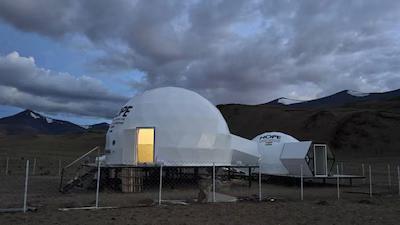
ISRO Sets Up Station in Ladakh to Simulate Life on Moon & Mars
In a significant breakthrough in space exploration, the Indian Space Research Organisation (ISRO) has set up the Himalayan Outpost for Planetary Exploration (HOPE) in Ladakh’s Tso Kar Valley. The station, which is designed to simulate life on the Moon and Mars, will test the life-support systems for lunar and Martian missions. The valley was chosen for its unique environment, which is similar to that on Mars, with high UV radiation, low atmospheric pressure, extreme cold, and saline permafrost.
The HOPE station is a crucial step towards India’s ambitious plans to send humans to the Moon and Mars in the near future. The 10-day simulation mission, which began on August 1, will see two crew members undertaking various tests at the facility. The mission aims to assess the performance of the life-support systems, communication networks, and other essential components that will be required for future space missions.
The Tso Kar Valley was chosen for the simulation mission due to its unique environment, which is reminiscent of the Martian terrain. The valley is located at an altitude of around 4,500 meters and experiences extreme cold temperatures, with temperatures often dropping to as low as -20°C. The high UV radiation and low atmospheric pressure also make it an ideal location to simulate the harsh conditions on Mars.
The HOPE station is equipped with state-of-the-art facilities, including life-support systems, communication networks, and scientific equipment. The crew members will conduct various tests, including experiments on soil, air, and water, to assess the feasibility of sustaining life on the Moon and Mars. The mission will also focus on testing the psychological and physical effects of long-duration space travel on the human body.
The ISRO has been working on its lunar and Martian missions for several years, and the HOPE station is a significant step towards realizing these ambitions. In 2022, ISRO plans to send its first crewed mission to the Moon, which will mark a major milestone in the country’s space exploration program.
The HOPE station is also an important step towards developing India’s capabilities in space exploration. The country has made significant progress in recent years, including the successful launch of the Chandrayaan-1 mission in 2008 and the Mangalyaan mission to Mars in 2013. The ISRO has also been working on its Gaganyaan program, which aims to develop a crewed spacecraft capable of carrying astronauts to the Moon and beyond.
The HOPE station is a testament to India’s commitment to space exploration and its ambitious plans to become a major player in the global space industry. The country’s space program has the potential to drive economic growth, create new job opportunities, and enhance national prestige.
In conclusion, the ISRO’s HOPE station in Ladakh’s Tso Kar Valley is a significant step towards simulating life on the Moon and Mars. The 10-day simulation mission will provide valuable insights into the performance of life-support systems, communication networks, and other essential components required for future space missions. The HOPE station is an important milestone in India’s space exploration program and a testament to the country’s commitment to becoming a major player in the global space industry.






